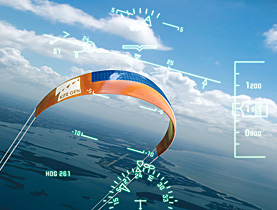
Ships to power up with giant kites

Cargo ships and other seagoing vessels may soon be partly powered by high-altitude kites under a European project supported by Swiss researchers.
The Arc Engineering College in western Switzerland is one of nine European universities and partners working on the three-year KitVes venture, launched last year, to generate electricity on board ships.
Unlike a previous concept announced in 2008, which uses kites to harness wind power to supplement ships’ propulsion systems, the KitVes project generates electricity to support onboard auxiliary services, such as electronic equipment and air conditioning.
It generates power by raising and lowering 100m2 kites to and from altitudes of 1,000 metres, explained Valérie Briquez, coordinator for the project at the Arc Engineering College based in Le Locle.
“A kite flying at high altitude catches the wind. It pulls on cables and this traction causes an electrical generator to rotate,” Briquez told swissinfo.ch.
When the cables are entirely unwound the kite is guided to a position where it loses its wind resistance and the cables are wound in.
Based on this “yo-yo” phenomenon, the energy consumed by the winding phase is just a fraction of that generated during the unwinding stage.
The idea for the European Union-funded project was dreamed up by the Italian company Sequoia Automation, which is also developing kite-powered wind farms.
Ups and downs
“The difficulty will be to bring the kite back down without wasting energy or as little as possible,” she said. But if sufficient energy is generated, it could be used to power an electric motor on a ship, added the Swiss coordinator.
According to the KitVes website, the current project could generate between 60 kilowatts and 30 megawatts of power for one ship, depending on the set-up.
“Different studies have shown that in the troposphere, situated between eight to 15 kilometres [above sea level], there is always constant wind,” Briquez said.
At higher altitudes, average wind speed increases. At 80 metres above the ground, the height of the latest generation of wind turbines, the average wind speed is estimated at 4.6 m/s while at 10 metres above ground level it is even lower – 3.3 m/s.
Experts say wind power starts to become interesting at 800 metres, with constant winds of around 7.2 m/s, which can generate almost four times the wind power of wind turbines (205 watts per square metre versus 58W/m2).
In the KitVes project, kite wings will be fitted with electronic sensors so that data on position, acceleration and orientation can be sent to a control unit on the boat.
Motors located on board the vessel will control the kite’s flight paths and also act as power generators.
Further testing
The Arc Engineering College, which has specific mechanical and electronic expertise, is responsible for three specific areas of the KitVes project.
“We have to work out how to supply the sensors with energy when they are flying at an altitude of one kilometre,” explained Briquez.
Researchers at Le Locle will also carry out tests on the resistance of polyethylene cables used on the kites. And they will devise a computerised mathematical model of all possible movements of the kite, cables and motors, to be able to predict its behaviour.
“It’s an extremely gratifying project, as it promotes our skills and is attractive for students. The new generation of students is very interested in renewable energies,” said Briquez.
Other KitVes partners will be looking into issues like materials, security at sea, flying regulations and the prototype boat.
So far, the kite’s yo-yo effect has been successfully tested on terra firma on specially adapted trucks, but two ships have been identified and a prototype should be ready next year.
Simon Bradley, swissinfo.ch
The German company SkySails has developed ship-pulling kites as a supplementary power source for cargo ships, first tested in January 2008 on the MS Beluga SkySails ship.
The company claims that freight ships, and even cruise liners, could reduce fuel consumption by up to 35 per cent under optimal conditions.
Experimental high-altitude wind-power systems using kites are currently being developed by the firm Makani Power in California, and, Sequoia Automation, based in Italy, with its KitGen power plant system.
KitGen says its 100 megawatt kite power plant can produce approximately 500 GWh yearly. This is the amount that 86,000 Europeans consumed in 2003.
According to an April 2009 International Maritime Organisation (IMO) report, combined domestic and international shipping accounts for about 3.3 per cent of the world’s total carbon dioxide emissions, more than railroad freight (0.5 per cent) and airlines (1.9 per cent) combined.
Shipping and aviation are the only industry sectors not regulated under the Kyoto Protocol, which sets targets for greenhouse gas emissions by rich countries from 2008-12.
Pressure has grown for cuts ahead of a crucial climate change summit in Copenhagen in December. If nothing is done, experts expect emissions from shipping to rise by 30 per cent by 2020.
Delegates from member state countries of the International Maritime Organization (IMO) in July approved non-compulsory technical and operational measures to reduce greenhouse emissions from ships.
Environmental groups argue the measures did not go far enough given opposition from China and India.

In compliance with the JTI standards
More: SWI swissinfo.ch certified by the Journalism Trust Initiative






























You can find an overview of ongoing debates with our journalists here . Please join us!
If you want to start a conversation about a topic raised in this article or want to report factual errors, email us at english@swissinfo.ch.